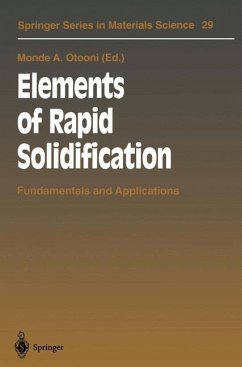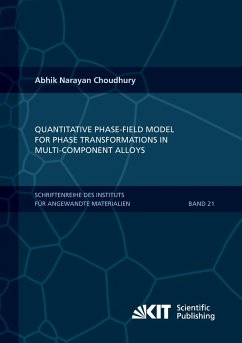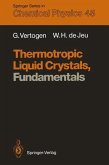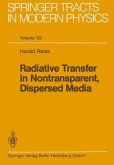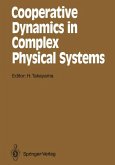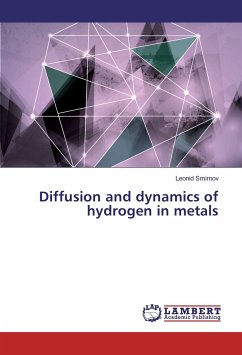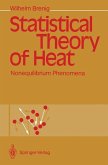Elements of Rapid Solidification
Fundamentals and Applications
Herausgegeben:Otooni, Monde A.
Elements of Rapid Solidification
Fundamentals and Applications
Herausgegeben:Otooni, Monde A.
- Broschiertes Buch
- Merkliste
- Auf die Merkliste
- Bewerten Bewerten
- Teilen
- Produkt teilen
- Produkterinnerung
- Produkterinnerung
Elements of Rapid Solidification: Fundamentals and Applications is the product of many years of concentrated work in the field of rapid solidification and processing. This quasi-monograph is unique in two ways. It brings together the talent of many international scientists in an effort to focus attention on all aspects of a new scientific field and it concentrates on fundamentals and practical applications. Simply stated, this book has been written by the senior students in the field of rapid solidification technology for the new generation of solid-state physicists, materials scientists, materials engineers, metallurgists and ceramicists.…mehr
Andere Kunden interessierten sich auch für
![Quantitative phase-field model for phase transformations in multi-component alloys Quantitative phase-field model for phase transformations in multi-component alloys]() Abhik Narayan ChoudhuryQuantitative phase-field model for phase transformations in multi-component alloys46,00 €
Abhik Narayan ChoudhuryQuantitative phase-field model for phase transformations in multi-component alloys46,00 €![Thermotropic Liquid Crystals, Fundamentals Thermotropic Liquid Crystals, Fundamentals]() Ger VertogenThermotropic Liquid Crystals, Fundamentals77,99 €
Ger VertogenThermotropic Liquid Crystals, Fundamentals77,99 €![Radiative Transfer in Nontransparent, Dispersed Media Radiative Transfer in Nontransparent, Dispersed Media]() Harald ReissRadiative Transfer in Nontransparent, Dispersed Media39,99 €
Harald ReissRadiative Transfer in Nontransparent, Dispersed Media39,99 €![Elementary Excitations in Quantum Fluids Elementary Excitations in Quantum Fluids]() Elementary Excitations in Quantum Fluids77,99 €
Elementary Excitations in Quantum Fluids77,99 €![Cooperative Dynamics in Complex Physical Systems Cooperative Dynamics in Complex Physical Systems]() Cooperative Dynamics in Complex Physical Systems39,99 €
Cooperative Dynamics in Complex Physical Systems39,99 €![Diffusion and dynamics of hydrogen in metals Diffusion and dynamics of hydrogen in metals]() Leonid SmirnovDiffusion and dynamics of hydrogen in metals31,99 €
Leonid SmirnovDiffusion and dynamics of hydrogen in metals31,99 €![Statistical Theory of Heat Statistical Theory of Heat]() Wilhelm BrenigStatistical Theory of Heat38,99 €
Wilhelm BrenigStatistical Theory of Heat38,99 €-
-
-
Elements of Rapid Solidification: Fundamentals and Applications is the product of many years of concentrated work in the field of rapid solidification and processing. This quasi-monograph is unique in two ways. It brings together the talent of many international scientists in an effort to focus attention on all aspects of a new scientific field and it concentrates on fundamentals and practical applications. Simply stated, this book has been written by the senior students in the field of rapid solidification technology for the new generation of solid-state physicists, materials scientists, materials engineers, metallurgists and ceramicists.
Produktdetails
- Produktdetails
- Springer Series in Materials Science 29
- Verlag: Springer / Springer Berlin Heidelberg / Springer, Berlin
- Artikelnr. des Verlages: 978-3-642-45757-9
- Softcover reprint of the original 1st ed. 1998
- Seitenzahl: 264
- Erscheinungstermin: 7. März 2012
- Englisch
- Abmessung: 235mm x 155mm x 15mm
- Gewicht: 405g
- ISBN-13: 9783642457579
- ISBN-10: 3642457576
- Artikelnr.: 36116512
- Herstellerkennzeichnung
- Springer-Verlag GmbH
- Tiergartenstr. 17
- 69121 Heidelberg
- ProductSafety@springernature.com
- Springer Series in Materials Science 29
- Verlag: Springer / Springer Berlin Heidelberg / Springer, Berlin
- Artikelnr. des Verlages: 978-3-642-45757-9
- Softcover reprint of the original 1st ed. 1998
- Seitenzahl: 264
- Erscheinungstermin: 7. März 2012
- Englisch
- Abmessung: 235mm x 155mm x 15mm
- Gewicht: 405g
- ISBN-13: 9783642457579
- ISBN-10: 3642457576
- Artikelnr.: 36116512
- Herstellerkennzeichnung
- Springer-Verlag GmbH
- Tiergartenstr. 17
- 69121 Heidelberg
- ProductSafety@springernature.com
1 Introduction and Background.- 1.1 Background.- 1.2 Liquid-to-Crystal Transition: Undercooling and Nucleation.- 1.3 Metallic Glasses.- 1.4 Metastable Crystalline Phases.- References.- 2 Synthesis and Processing.- 2.1 Heat Transfer and Solidification Kinetics.- 2.2 Droplet Methods.- 2.3 Spinning Methods.- 2.4 Surface Melting Technologies.- 2.5 Consolidation Technologies.- References.- 3 Structure and Characterization of Rapidly Solidified Alloys.- 3.1 Characterization Techniques.- 3.2 Total Scattering Intensity from Amorphous and Nanocrystalline Alloys.- 3.3 Diffraction Theory of Powder Pattern Peaks from Nanocrystalline Materials.- 3.4 Experimental Diffraction Techniques.- 3.5 Structure of Amorphous and Nanocrystalline Alloys.- 3.6 Selected Examples of Electron-Microscopy Analysis.- References.- 4 Atomic Transport and Relaxation in Rapidly Solidified Alloys.- 4.1 Basic Equations of Diffusion.- 4.2 Self-Diffusion in Amorphous Alloys.- 4.3 Theory of Diffusion in Disordered Media.- 4.4 Diffusion of Hydrogen Isotopes and Light Particles in Amorphous Alloys.- 4.5 Magnetic After-Effects and Induced Anisotropies Due to Double-Well Systems in Amorphous Alloys.- 4.6 Viscosity and Internal Friction of Amorphous Alloys.- Appendix: Microsectioning by Ion-Beam Sputtering - A Powerful Method to Determine Diffusion Profiles.- References.- 5 Mechanical Properties and Behaviour.- 5.1 Elastic and Anelastic Behaviour.- 5.2 Plastic Flow and Fracture Behaviour.- 5.3 Strength and Hardness.- 5.4 Fatigue and Wear Behaviour.- 5.5 Creep and Hot Deformation Behaviour.- References.- 6 Magnetic and Electronic Properties of Rapidly Quenched Materials.- 6.1 Rapidly Quenched Alloys.- 6.2 Fundamental Magnetic Properties.- 6.3 Domains and Technical Properties of Amorphous Alloys.- 6.4 Magnetism andShort-Range Order.- 6.5 Electronic Structure of Amorphous Alloys.- 6.6 Applications.- 6.7 Conclusion, Outlook.- References.- 7 Chemical Properties of Amorphous Alloys.- 7.1 Corrosion-Resistant Alloys in Aqueous Solutions.- 7.2 Corrosion-Resistant Alloys at High Temperatures.- 7.3 Electrodes for Electrolysis of Aqueous Solutions.- 7.4 Catalysts for Prevention of the Greenhouse Effect and Saving the Ozone Layer.- 7.5 Concluding Remarks.- References.- 8 Selected Examples of Applications.- 8.1 Improvement of Mechanical Properties.- 8.2. Magnetic Applications.- 8.3 Joining Applications.- 8.4 Current Limitations and Future Directions.- Further Reading.- 9 Glossary of Important Terms.
1 Introduction and Background.- 1.1 Background.- 1.2 Liquid-to-Crystal Transition: Undercooling and Nucleation.- 1.3 Metallic Glasses.- 1.4 Metastable Crystalline Phases.- References.- 2 Synthesis and Processing.- 2.1 Heat Transfer and Solidification Kinetics.- 2.2 Droplet Methods.- 2.3 Spinning Methods.- 2.4 Surface Melting Technologies.- 2.5 Consolidation Technologies.- References.- 3 Structure and Characterization of Rapidly Solidified Alloys.- 3.1 Characterization Techniques.- 3.2 Total Scattering Intensity from Amorphous and Nanocrystalline Alloys.- 3.3 Diffraction Theory of Powder Pattern Peaks from Nanocrystalline Materials.- 3.4 Experimental Diffraction Techniques.- 3.5 Structure of Amorphous and Nanocrystalline Alloys.- 3.6 Selected Examples of Electron-Microscopy Analysis.- References.- 4 Atomic Transport and Relaxation in Rapidly Solidified Alloys.- 4.1 Basic Equations of Diffusion.- 4.2 Self-Diffusion in Amorphous Alloys.- 4.3 Theory of Diffusion in Disordered Media.- 4.4 Diffusion of Hydrogen Isotopes and Light Particles in Amorphous Alloys.- 4.5 Magnetic After-Effects and Induced Anisotropies Due to Double-Well Systems in Amorphous Alloys.- 4.6 Viscosity and Internal Friction of Amorphous Alloys.- Appendix: Microsectioning by Ion-Beam Sputtering - A Powerful Method to Determine Diffusion Profiles.- References.- 5 Mechanical Properties and Behaviour.- 5.1 Elastic and Anelastic Behaviour.- 5.2 Plastic Flow and Fracture Behaviour.- 5.3 Strength and Hardness.- 5.4 Fatigue and Wear Behaviour.- 5.5 Creep and Hot Deformation Behaviour.- References.- 6 Magnetic and Electronic Properties of Rapidly Quenched Materials.- 6.1 Rapidly Quenched Alloys.- 6.2 Fundamental Magnetic Properties.- 6.3 Domains and Technical Properties of Amorphous Alloys.- 6.4 Magnetism andShort-Range Order.- 6.5 Electronic Structure of Amorphous Alloys.- 6.6 Applications.- 6.7 Conclusion, Outlook.- References.- 7 Chemical Properties of Amorphous Alloys.- 7.1 Corrosion-Resistant Alloys in Aqueous Solutions.- 7.2 Corrosion-Resistant Alloys at High Temperatures.- 7.3 Electrodes for Electrolysis of Aqueous Solutions.- 7.4 Catalysts for Prevention of the Greenhouse Effect and Saving the Ozone Layer.- 7.5 Concluding Remarks.- References.- 8 Selected Examples of Applications.- 8.1 Improvement of Mechanical Properties.- 8.2. Magnetic Applications.- 8.3 Joining Applications.- 8.4 Current Limitations and Future Directions.- Further Reading.- 9 Glossary of Important Terms.

